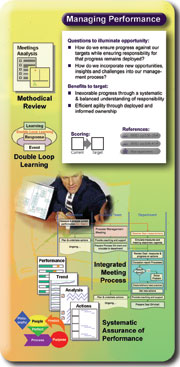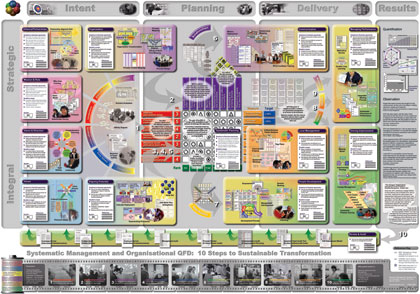Managing Performance
  Within the Systematic Management model
the intention is that, in the first instance, performance is
managed locally within the processes that deliver that performance.
The reason for this is that local management are in the best
place to understand and manage that performance - to balance
improvement against exigencies. Delegating this responsibility
however does not absolve senior management from the responsbility
of ensuring that the separate process teams are effective in
working separately and together to fulfil their individual and
collective goals. Within the Systematic Management model
the intention is that, in the first instance, performance is
managed locally within the processes that deliver that performance.
The reason for this is that local management are in the best
place to understand and manage that performance - to balance
improvement against exigencies. Delegating this responsibility
however does not absolve senior management from the responsbility
of ensuring that the separate process teams are effective in
working separately and together to fulfil their individual and
collective goals.
 The challenge of managing performance at the top
level is one of maintaining progress whilst ensuring ownership
remains deployed, and to meet this challenge requires a focus
on the process of management rather than the detail of it. The challenge of managing performance at the top
level is one of maintaining progress whilst ensuring ownership
remains deployed, and to meet this challenge requires a focus
on the process of management rather than the detail of it.
 The tools shown on the panel reflect some of the
ways in which management can meet this challenge: The tools shown on the panel reflect some of the
ways in which management can meet this challenge:

|
 Double
Loop Learning is
a concept extensively promoted by Chris Agyris as an essential
component of the Learning
Organisation. In simple terms it is about monitoring our
standard responses to problems, and looking at how our learning
(problem solving, thinking) processes can be improved to make
them more effective. This reflects the essence
of the role of the the top-team vis-a-vis process teams -
one of looking at the effectiveness of their thinking processes
and helping them to find ways to make them more (or more consistently)
effective - a meta-perspective on
their systems of working and patterns of thinking. Double
Loop Learning is
a concept extensively promoted by Chris Agyris as an essential
component of the Learning
Organisation. In simple terms it is about monitoring our
standard responses to problems, and looking at how our learning
(problem solving, thinking) processes can be improved to make
them more effective. This reflects the essence
of the role of the the top-team vis-a-vis process teams -
one of looking at the effectiveness of their thinking processes
and helping them to find ways to make them more (or more consistently)
effective - a meta-perspective on
their systems of working and patterns of thinking.
|

|
 The Double Loop Learning theory is worked out in
practice through what is refered to on the panel as Systematic
Assurance of Performance. This involves a practical adoption
through the systematic model - which
is explained in more detail here,
and in this slide set (2.6
MB). In practical terms, the top team's role is to reconfirm
the purpose and philosophy
(targets) of the organisation, to review performance against
these (predict), to isolate shortfalls
to process deficiencies, to review
and empower the relevant process team's approach to these (people), and then to see how all of
this systematic approach could be improved still further (perfect). The Double Loop Learning theory is worked out in
practice through what is refered to on the panel as Systematic
Assurance of Performance. This involves a practical adoption
through the systematic model - which
is explained in more detail here,
and in this slide set (2.6
MB). In practical terms, the top team's role is to reconfirm
the purpose and philosophy
(targets) of the organisation, to review performance against
these (predict), to isolate shortfalls
to process deficiencies, to review
and empower the relevant process team's approach to these (people), and then to see how all of
this systematic approach could be improved still further (perfect).
|

|
 The Integrated Meeting Process is the practical means by which Systematic
Assurance of Performance is achieved. It is explained in some
detail in a slide set
(254 KB) and session plan
(153 KB) which can be used to introduce and manage such a meeting.
The structure of the meeting is one of reviewing top level performance
against what is needed/expected, and then looking for the reason
for any deficiencies within existing process issues (which should
be already being addressed). Where deficiencies are not explained,
or being effectively addressed by a process team, the top team
will adopt its 'double loop' responsibility,
and do what it needs to to fix/improve the learning process -
more often then not this involves coaching a process team on
their local management process, but can sometimes lead to new
insights into the QFD. The Integrated Meeting Process is the practical means by which Systematic
Assurance of Performance is achieved. It is explained in some
detail in a slide set
(254 KB) and session plan
(153 KB) which can be used to introduce and manage such a meeting.
The structure of the meeting is one of reviewing top level performance
against what is needed/expected, and then looking for the reason
for any deficiencies within existing process issues (which should
be already being addressed). Where deficiencies are not explained,
or being effectively addressed by a process team, the top team
will adopt its 'double loop' responsibility,
and do what it needs to to fix/improve the learning process -
more often then not this involves coaching a process team on
their local management process, but can sometimes lead to new
insights into the QFD.
|

|
 Methodical
Review is a simple
tool by which the top-team can reflect on and improve its own
performance. It is simply an opportunity at the end of the meeting
for people to consider what worked well within the meeting and
what could have been improved. It works effectively as a simple
open question, but occassionally it benefits from a bit more
structure (16 KB)
to encourage the team to reflect more broadly on their meeting
performance. Methodical
Review is a simple
tool by which the top-team can reflect on and improve its own
performance. It is simply an opportunity at the end of the meeting
for people to consider what worked well within the meeting and
what could have been improved. It works effectively as a simple
open question, but occassionally it benefits from a bit more
structure (16 KB)
to encourage the team to reflect more broadly on their meeting
performance.
|
 Pages 336-354 of Managing
by Design can be found in Chapter
21 which can be read as a pdf file (137 KB) by clicking the
link above. Pages 398-414 can be found in Chapter
25. Pages 336-354 of Managing
by Design can be found in Chapter
21 which can be read as a pdf file (137 KB) by clicking the
link above. Pages 398-414 can be found in Chapter
25.
 Blank templates of this panel can be found in the
Big Picture Storyboard
file - these can be used to capture your own experiences and
progress in this area (by annotating them either in PowerPoint,
or as a printed panel), and then to physically cut and paste
them onto the Big Picture to create your own storyboard of implementing
systematic management in your organisation. Blank templates of this panel can be found in the
Big Picture Storyboard
file - these can be used to capture your own experiences and
progress in this area (by annotating them either in PowerPoint,
or as a printed panel), and then to physically cut and paste
them onto the Big Picture to create your own storyboard of implementing
systematic management in your organisation.
To explore another secion of
the big picture, please click on the relevant area of the image
below:

 Home - Load frames - About
us - Resources - Contact
us Home - Load frames - About
us - Resources - Contact
us
© Tesseract
Management Systems Ltd 2006 |
 |
Fast Perspectives:
(click below for an oversight)
Get your own Big Picture
(Purchase the Big Picture as a high
quality wall chart)
The best systematic
resources now available.
(tools and methodologies)
Testimonials on systematic management
|

![]() Within the Systematic Management model
the intention is that, in the first instance, performance is
managed locally within the processes that deliver that performance.
The reason for this is that local management are in the best
place to understand and manage that performance - to balance
improvement against exigencies. Delegating this responsibility
however does not absolve senior management from the responsbility
of ensuring that the separate process teams are effective in
working separately and together to fulfil their individual and
collective goals.
Within the Systematic Management model
the intention is that, in the first instance, performance is
managed locally within the processes that deliver that performance.
The reason for this is that local management are in the best
place to understand and manage that performance - to balance
improvement against exigencies. Delegating this responsibility
however does not absolve senior management from the responsbility
of ensuring that the separate process teams are effective in
working separately and together to fulfil their individual and
collective goals.![]() The challenge of managing performance at the top
level is one of maintaining progress whilst ensuring ownership
remains deployed, and to meet this challenge requires a focus
on the process of management rather than the detail of it.
The challenge of managing performance at the top
level is one of maintaining progress whilst ensuring ownership
remains deployed, and to meet this challenge requires a focus
on the process of management rather than the detail of it.![]() The tools shown on the panel reflect some of the
ways in which management can meet this challenge:
The tools shown on the panel reflect some of the
ways in which management can meet this challenge:![]() Pages 336-354 of Managing
by Design can be found in Chapter
21 which can be read as a pdf file (137 KB) by clicking the
link above. Pages 398-414 can be found in Chapter
25.
Pages 336-354 of Managing
by Design can be found in Chapter
21 which can be read as a pdf file (137 KB) by clicking the
link above. Pages 398-414 can be found in Chapter
25.![]() Blank templates of this panel can be found in the
Big Picture Storyboard
file - these can be used to capture your own experiences and
progress in this area (by annotating them either in PowerPoint,
or as a printed panel), and then to physically cut and paste
them onto the Big Picture to create your own storyboard of implementing
systematic management in your organisation.
Blank templates of this panel can be found in the
Big Picture Storyboard
file - these can be used to capture your own experiences and
progress in this area (by annotating them either in PowerPoint,
or as a printed panel), and then to physically cut and paste
them onto the Big Picture to create your own storyboard of implementing
systematic management in your organisation.